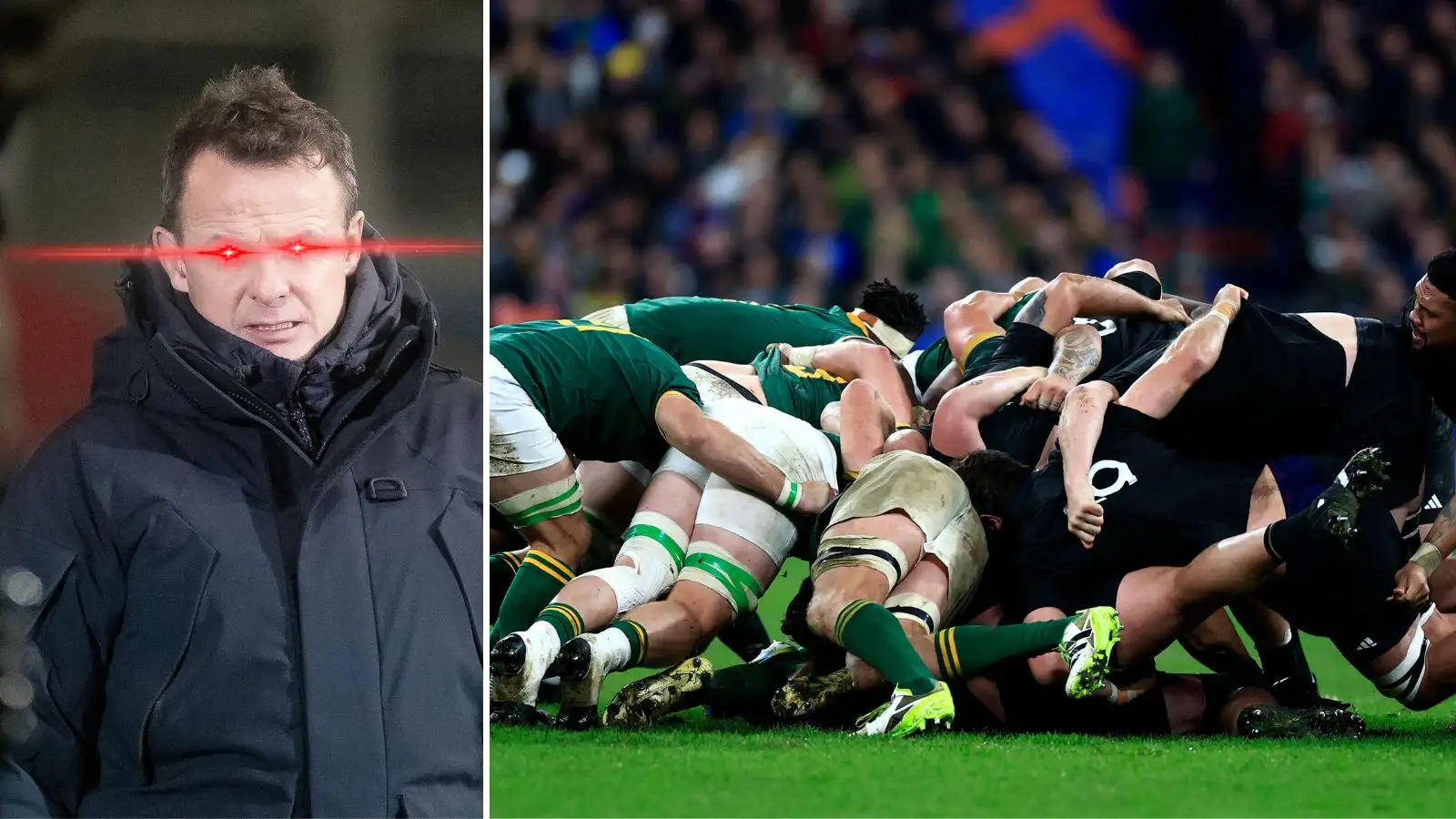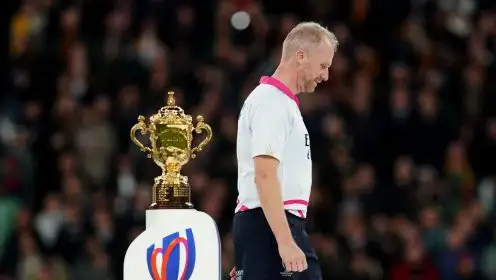Loose Pass: ‘Sharp-eyed’ Austin Healey v TMOs and depowering scrums

Ex-England and Lions back Austin Healey and the Springboks and All Blacks scrum during the Rugby World Cup Final.
This week we will mostly be concerning ourselves with a rough weekend for the TMO and the latest instalment of the scrum debate…
The media v the TMO?
In the end, we’re told, it’s about getting to the correct decision. And the more often we do that, the better it will be in the end. This, by and large, is the justification for the proliferation of often interminable TMO interventions in rugby. The endless minutes spent scouring the angles. The interruptions. The questions. The protocols. Wordings. Speeds. Angles.
There is a generally accepted overall trend (we’re not privy to exact statistics, unfortunately) that more decisions are right these days than they used to be.
Whether that tendency is worth the amount of in-game dead time it costs is also very much up for debate, yet trying to trim that is also a problem. Take New Zealand’s grievances after play was brought back for a knock-on in the World Cup Final as an example. It was rightly brought back because of the knock-on, yet wrongly because normally the TMO cannot refer back to an incident that far in the past.
But the weekend past was a real dog’s dinner for TMOs. It was not just Stuart Terheege ignoring the foul play on Owen Farrell; there was also a forward pass as clear as day, which directly led to a Bath try against the Sale Sharks.
As Stephen Lewies’ knee-drop on Owen Farrell also was, this forward pass was flagged up on the TV coverage by one Austin Healey. And, strangely, it was summarily ignored despite being a clear and obvious error and being replayed and viewed before Finn Russell’s conversion. As was a knock-on by a Sale player in a movement which also led to a try later in the game.
RFU to investigate Saracens v Harlequins TMO controversy as Joe Marler wades in
Also this- TMO yelling “oh don’t show it”. Is this actually allowed?
Some interesting questions for @premrugby & @rugbyontnt
One for @stephenjones9
& other rugby journos to query pic.twitter.com/7OGKicN1R8— Tom Finn-Kelcey (@TFinnKelcey) March 23, 2024
Firstly, it ought to be noted that Healey is a remarkably sharp-eyed pundit. Loose Pass did not notice, or even suspect, the knock-on in the Sale-Bath clash, for example. Very few did. It would not be the first time he picked out something very few others had spotted either.
Mr. Healey is also not one, as has been well-documented down the years, to hold back when he thinks there’s something to say; it is what makes him very good at what he does, and it is also what has made him not to everybody’s taste.
If, as seems to be very clear from the footage of the Lewies incident, TMOs do, in fact, sometimes get commentary as well as footage from the television coverage feeds, so what? It is perhaps different at the international level, but for domestic games, the commentators are extremely rarely one-eyed (European and international games are sometimes different).
Moreover, even if they can’t hear the chat, they’d see the TV feed pictures, see the replays which are directly instigated by what the pundits say. And in the end, especially when it comes to actions such as that of Lewies, who would not wish to have an extra pair of eyes pointing things out during a rugby match?
You can understand Mr. Terheege’s wish not to be seen – or not to be in a position to be seen – as having been influenced by the commentary, but it beggars belief that anybody would actively wish to not come to the right decision – and looking at the timing of the replays of the incidents in the Bath-Sale game you almost wonder if a similar exchange didn’t go on behind the scenes in that one either. Both were incidents without an iota of doubt.
There seems to be no love lost between the sides. In the first exchange during the replay of the Lewies incident, Mr. Terheege refers to ‘Healey’ initially, before correcting it to Austin, hardly a mark of mutual respect. The social media reply from Mr. Healey about ego getting in the way of a decision poured oil onto a burning fire and was very unnecessary. His vocalised exasperation at the lack of TMO intervention despite replays on Sunday – “I can’t believe they’re not looking at this” – probably didn’t help anything either.
And maybe it is Mr. Healey’s impatience and willingness to call things as he sees them which gets him on the wrong side of some officials? He’s not always right, nobody is and officials, as has been well-documented, are under far more pressure than most to get the decisions right, even the difficult ones. Understandably, they don’t want to be seen as being influenced. But you’d surely rather run that risk than ignore clear and obvious errors which you are paid to pick up.
Mr. Healey, calling what he sees, is doing his job. And in the final analysis of the weekend’s events, he was the one who did so; the TMOs did not.
Lobby group slams TMO for ‘dereliction’ of duty after ‘reckless’ play on Owen Farrell is ignored
The future of the scrum

Nigel Owens’ take on the scrum being ‘depowered’ this week was on the mark, but is illustrative of just how hard it is to govern an aspect of the game which has been so thoroughly changed by the advent of professionalism that it is barely recognisable from what it was, or was designed for.
Once upon a time, it was simply a mass of fellows genuinely pushing hard against each other for a ball that had to be put into the middle of it. Hookers had to hook; opposing hookers would try to hook too. The engagement came as fast as possible – woe betide the team that wasn’t ready or pulled out.
Then came professionalism. Props got bigger. A lot bigger. Stances changed. There was the concept of getting the ‘hit’ in the front row, only exacerbated by the ‘engage’ calls introduced to help referees stop teams thundering into the front-row collision early and reduce the danger of the opposition collapsing onto itself.
As coaches realised that shoves would be more effective if players were lower, the engagement height dropped so much that it was biomechanically impossible for hookers to reach balls put into the middle, so now that’s been done away with too.
Binding onto each other right takes an aeon. The protagonists spend so long getting themselves and their team-mates into position that an entire scrum from whistle to put-in can often take up to 90 seconds – in a game with ten scrums, that’s pretty much a fifth of the game time. And then one collapses without blame being apportioned, and we’re off for another 90 seconds.
It’s understandable for teams with a scrum as a strong weapon to be unhappy that they are not able to opt for a scrum from free-kicks, but it is just as understandable that those who wish for the game to be more open would not want to waste more time than is necessary and would prefer them to be a genuine way of restarting the game rather than a specific tactical option. At least we still have the pushing contests for those who like them.



